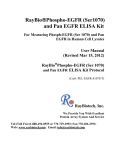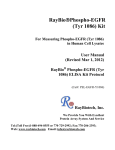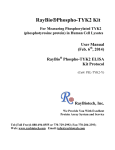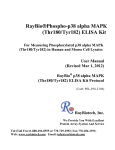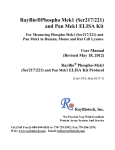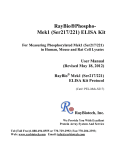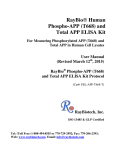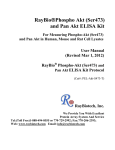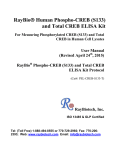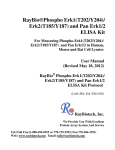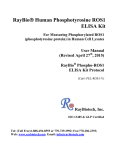Download Preliminary Manual
Transcript
RayBio Phospho-ELISA Kit For Measuring Phosphorylated specific protein (phosphotyrosine protein) in Human Cell Lysates User Manual (Revised Sept 4, 2013) RayBio Phospho-ELISA Kit Protocol RayBiotech, Inc. We Provide You With Excellent Protein Array System And Service Tel:(Toll Free)1-888-494-8555 or 770-729-2992; Fax:770-206-2393; Web: www.raybiotech.com Email: [email protected] RayBiotech, Inc. RayBio Phospho-ELISA Kit Protocol TABLE OF CONTENTS I. Introduction……..……………………………….2 II. Material Provided…………..………..…………..2 III. Storage.…………………………………….…….3 IV. Additional Materials Required…………………..4 V. Sample Preparation………………………………4 VI. Reagent Preparation……………………….…......5 VII. Assay Procedure………………………………....6 VIII. Assay Procedure Summary……………………....7 IX. Typical Data..........................................................8 X. Troubleshooting Guide.………………...…..........9 1 RayBioPhospho-ELISA I. INTRODUCTION RayBioPhospho-ELISA (Enzyme-Linked Immunosorbent Assay) kit is a very rapid, convenient and sensitive assay kit that can monitor the activation or function of important biological pathways in cell lysates. By determining phospho specific protein in your experimental model system, you can verify pathway activation in your cell lysates. You can simultaneously measure numerous different cell lysates without spending excess time and effort in performing a Western Blot analysis. This Sandwich ELISA kit is an in vitro enzyme-linked immunosorbent assay for the measurement of human phospho specific protein. A specific capture antibody has been coated onto a 96-well plate. Samples are pipetted into the wells and phosphorylated and unphosphorylated protein present in a sample is bound to the wells by the immobilized antibody. The wells are washed and biotinylated anti-phosphotyrosine antibody is used to detect only tyrosine-phosphorylated protein. After washing away unbound antibody, HRP-conjugated streptavidin is pipetted to the wells. The wells are again washed, a TMB substrate solution is added to the wells and color develops in proportion to the amount of phosphor specific protein bound. The Stop Solution changes the color from blue to yellow, and the intensity of the color is measured at 450 nm. II. MATERIAL PROVIDED 1. Microplate (Item A): 96 wells (12 strips x 8 wells) coated with specific capture antibody. 2 RayBioPhospho-ELISA 2. Wash Buffer Concentrate (20x) (Item B): 25 ml of 20x concentrated solution. 3. Assay Diluent (Item E): 15 ml of 5x concentrated buffer. For diluting cell lysate sample, detection antibody (Item C) and HRP-Streptavidin Concentrate (Item G). 4. Biotinylated anti-phosphotyrosine (Item C): 2 vial of biotinylated anti-phosphotyrosine (each vial is enough to assay half microplate). 5. HRP-Streptavidin Concentrate (Item G): 1 vials, 200 µl/vial, concentrated HRP-conjugated streptavidin. 6. TMB One-Step Substrate Reagent (Item H): 12 ml of 3,3’,5,5’-tetramethylbenzidine (TMB) in buffered solution. 7. Stop Solution (Item I): 8 ml of 0.2 M sulfuric acid. 8. Cell Lysate Buffer (Item J): 5 ml 2x cell lysis buffer (not including protease and phosphatase inhibitors). 9. Positive Control (Item K): 1 vial of lyophilized powder from cell lysates. III. STORAGE Upon receipt, the kit should be stored at –20 °C. Please use within 6 months from the date of shipment. After initial use, Wash Buffer Concentrate (Item B), Assay Diluent (Item E), TMB One-Step Substrate Reagent (Item H), HRP-Streptavidin (Item G), Stop Solution (Item I) and Cell Lysate Buffer (Item J) should be stored at 4 °C to avoid repeated freeze-thaw cycles. Return unused wells to the pouch containing desiccant pack, reseal along entire edge and store at –20 °C. Reconstituted Positive Control (Item K) should be stored at -70 °C. 3 RayBioPhospho-ELISA IV. ADDITIONAL MATERIALS REQUIRED 1 2 3 4 5 6 7 8 Microplate reader capable of measuring absorbance at 450 nm. Protease and Phosphatase inhibitors. Shaker. Precision pipettes to deliver 2 µl to 1 ml volumes. Adjustable 1-25 ml pipettes for reagent preparation. 100 ml and 1 liter graduated cylinders. Distilled or deionized water. Tubes to prepare sample dilutions. V. SAMPLE PREPARATION Cell lysates - Rinse cells with PBS, making sure to remove any remaining PBS before adding the lysis buffer. Solubilize cells at 4 x 107 cells/ml in 1x Lysis Buffer (we recommend adding protease and phosphatase inhibitors to lysis buffer prior to sample preparation). Pipette up and down to resuspend and incubate the lysates with shaking at 2 - 8° C for 30 minutes. Microcentrifuge at 13,000 rpm for 10 minutes at 2 - 8° C, and transfer the supernates into a clean test tube. Lysates should be used immediately or aliquoted and stored at –70 °C. Avoid repeated freeze-thaw cycles. Thawed lysates should be kept on ice prior to use. For the initial experiment, we recommend to do a serial dilution testing such as 5-fold and 100-fold dilution for your cell lysates with Assay Diluent (Item E) before use. Note: The dilution fold of sample used depends on the abundance of phosphorylated proteins and should be determined empirically. 4 RayBioPhospho-ELISA More of the sample can be used if signals are too weak. If signals are too strong, the sample can be diluted further. Cell lysate buffer should be diluted 2-fold with deionized or distilled water before use (recommend to add protease and phosphatase inhibitors). VI. REAGENT PREPARATION 1. Bring all reagents and samples to room temperature (18 - 25°C) before use. 2. Item E, Assay Diluent should be diluted 5-fold with deionized or distilled water before use. 3. Preparation of Positive Control: [data pending] 4. If the Wash Concentrate (20x) (Item B) contains visible crystals, warm to room temperature and mix gently until dissolved. Dilute 20 ml of Wash Buffer Concentrate into deionized or distilled water to yield 400 ml of 1x Wash Buffer. 5. Briefly spin the biotinylated antibody (Item C) before use. Add 100 µl of 1x Assay Diluent into the vial to prepare a biotinylated anti-phosphotyrosine antibody concentrate. Pipette up and down to mix gently (the concentrate can be stored at 4° for 5 days or at -80°C for one month). The biotinylated phosphotyrosine antibody should be diluted with 1x Assay Diuent and used in step 4 of Part VII Assay Procedure. 5 RayBioPhospho-ELISA 6. Briefly spin the HRP-Streptavidin concentrate vial (Item G) and pipette up and down to mix gently before use. HRP-Streptavidin concentrate should be diluted with 1x Assay Diluent. 7. Cell Lysate Buffer should be diluted 2-fold with deionized or distilled water before use (recommend to add protease and phosphatase inhibitors). VII. ASSAY PROCEDURE: 1. Bring all reagents to room temperature (18 - 25°C) before use. It is recommended that all samples or Positive Control should be run at least in duplicate. 2. Add 100 µl of each sample or positive control into appropriate wells. Cover well with plate holder and incubate for 2.5 hours at room temperature or over night at 4°C with shaking. 3. Discard the solution and wash 4 times with 1x Wash Solution. Wash by filling each well with Wash Buffer (300 µl) using a multi-channel pipette or autowasher. Complete removal of liquid at each step is essential to good performance. After the last wash, remove any remaining Wash Buffer by aspirating or decanting. Invert the plate and blot it against clean paper towels. 4. Add 100 µl of prepared 1X biotinylated anti-phosphotyrosine antibody (Reagent Preparation step 5) to each well. Incubate for 1 hour at room temperature with shaking. 6 RayBioPhospho-ELISA 5. Discard the solution. Repeat the wash as in step 3. 6. Add 100 µl of prepared 1X HRP-Streptavidin solution (see Reagent Preparation step 6) to each well. Incubate for 45 minutes at room temperature with shaking. 7. Discard the solution. Repeat the wash as in step 3. 8. Add 100 µl of TMB One-Step Substrate Reagent (Item H) to each well. Incubate for 30 minutes at room temperature in the dark with shaking. 9. Add 50 µl of Stop Solution (Item I) to each well. Read at 450 nm immediately. VIII. ASSAY PROCEDURE SUMMARY 1. Prepare all reagents, samples and standards as instructed. 2. Add 100 µl sample or positive control to each well. Incubate 2.5 hours at room temperature or over night at 4oC. 3. Add 100 µl prepared 1X biotinylated phosphotyrosine antibody to each well. Incubate 1 hour at room temperature. 4. Add 100 µl prepared 1X HRP-Streptavidin solution. 7 RayBioPhospho-ELISA Incubate 45 minutes at room temperature. 5. Add 100 µl TMB One-Step Substrate Reagent to each well. Incubate 30 minutes at room temperature. 6. Add 50 µl Stop Solution to each well. Read at 450 nm immediately. IX. TYPICAL DATA A specific cell line will be determined in this assay: [data pending] 8 RayBioPhospho-ELISA X. TROUBLESHOOTING GUIDE Problem 1. Sample signals: a. Too low Cause Solution a. Sample concentration is too low a. Increasing sample concentration b. Sample concentration is too high b. Reducing sample concentration 2. Large CV a. Inaccurate pipetting a. Check pipettes 3. High background a. Plate is insufficiently washed a. Review the manual for proper washing. If using an automated plate washer, check that all ports are unobstructed. b. Contaminated wash buffer a. Improper storage of the ELISA kit b. Make fresh wash buffer a. Upon receipt, the kit should be stored at –20 oC. Store the positive control at -70oC after reconstitution. b. Stop solution b. Stop solution should be added to each well before measurement and read OD immediately. b. Too high 4. Positive Control: Low signal c. Improper primary or secondary antibody dilution 9 RayBioPhospho-ELISA c. Ensure correct dilution RayBio® ELISA kits: Choose from over 1000 ELISA kits for human, mouse, rat and a variety of other species. Visit www.raybiotech.com for the complete list. 10 RayBioPhospho-ELISA This product is for research use only. ©2004 RayBiotech, Inc. 11 RayBioPhospho-ELISA












